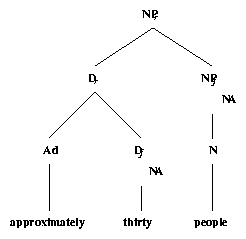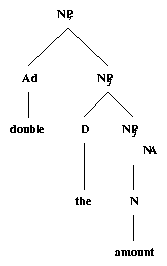

Although there is some debate in the literature as to whether these should be classified as determiners or adverbs, we believe that these items that interact with the NP and determiner system are in fact adverbs. These items exhibit a broader distribution than either determiners or adjectives in that they can modify many other phrasal categories, including adjectives, verb phrases, prepositional phrases, and other adverbs. Using the determiner feature system, we can obtain a close approximation to an accurate characterization of the behavior of the adverbs that interact with noun phrases and determiners. Adverbs can adjoin to either a determiner or a noun phrase (see figure 19.7), with the adverbs restricting what types of NPs or determiners they can modify by imposing feature requirements on the foot D or NP node. For example, the adverb approximately, seen in ((327)) above, selects for determiners that are card+. The adverb enough in ((332)) is an example of an adverb that selects for a noun phrase, specifically a noun phrase that is not modified by a determiner.
 |
 |
|
| (a) | (b) |
Most of the adverbs that modify determiners and NPs divide into six classes, with some minor variation within classes, based on the pattern of these restrictions. Three of the classes are adverbs that modify determiners, while the other three modify NPs. The largest of the five classes is the class of adverbs that modify cardinal determiners. This class includes, among others, the adverbs about, at most, exactly, nearly, and only. These adverbs have the single restriction that they must adjoin to determiners that are card+. Another class of adverbs consists of those that can modify the determiners every, all, any, and no. The adverbs in this class are almost, nearly, and practically. Closely related to this class are the adverbs mostly and roughly, which are restricted to modifying every and all, and hardly, which can only modify any. To select for every, all, and any, these adverbs select for determiners that are [quan+, card-, const+, compl+], and to select for no, the adverbs choose a determiner that is [quan+, decreas+, const+]. The third class of adverbs that modify determiners are those that modify the determiners few and many, representable by the feature sequences [quan+, decreas+, const-] and [quan+, decreas-, const-, 3pl, compl+], respectively. Examples of these adverbs are awfully, fairly, relatively, and very. Of the three classes of adverbs that modify noun phrases, one actually consists of a single adverb not, that only modifies determiners that are compl+. Another class consists of the focus adverbs, at least, even, only, and just. These adverbs select NPs that are wh- and card-. For the NPs that are card+, the focus adverbs actually modify the cardinal determiner, and so these adverbs are also included in the first class of adverbs mentioned in the previous paragraph. The last major class that modify NPs consist of the adverbs double and twice, which select NPs that are [definite+] (i.e., the, this/that/those/these, and the genitives). Although these restrictions succeed in recognizing the correct determiner/adverb sequences, a few unacceptable sequences slip through. For example, in handling the second class of adverbs mentioned above, every, all, and any share the features [quan+, card-, const+, compl+] with a and another, and so nearly a man is acceptable in this system. In addition to this over-generation within a major class, the adverb quite selects for determiners and NPs in what seems to be a purely idiosyncratic fashion. Consider the following examples.
In examples ((335)a)-((335)c), quite modifies the determiner, while in ((335)d)-((335)f), quite modifies the entire noun phrase. Clearly, it functions in a different manner in the two sets of sentences; in ((335)a)-((335)c), quite intensifies the amount implied by the determiner, whereas in ((335)d)-((335)f), it singles out an individual from the larger set to which it belongs. To capture the selectional restrictions needed for ((335)a)-((335)c), we utilize the two sets of features mentioned previously for selecting few and many. However, a few cannot be singled out so easily; using the sequence [quan+, card-, decreas-, const+, 3pl, compl-], we also accept the ungrammatical NPs quite several members and quite some members (where quite modifies some). In selecting the as in (d) with the features [definite+, gen-, 3sg], quite also selects this and that, which are ungrammatical in this position. Examples ((335)e) and ((335)f) present yet another obstacle in that in selecting another and a, quite erroneously selects every and any. It may be that there is an undiscovered semantic feature that would alleviate these difficulties. However, on the whole, the determiner feature system we have proposed can be used as a surprisingly efficient method of characterizing the interaction of adverbs with determiners and noun phrases.